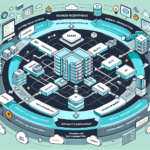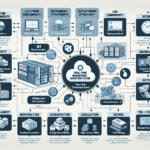Configuring IT infrastructure for supply chain management (SCM) systems involves designing a resilient, scalable, and secure environment that ensures the performance, availability, and data integrity of the SCM platform. Here’s a step-by-step guide to help you set up such infrastructure:
1. Understand the Requirements
- SCM Software Requirements: Identify the system requirements for the SCM software, including supported operating systems, databases, middleware, and resource needs (CPU, RAM, storage).
- Performance Expectations: Determine the expected transaction volumes, concurrent users, and response time goals.
- Integration Needs: Identify integration points with other systems, such as ERP, CRM, IoT devices, and business intelligence tools.
- Compliance: Consider industry standards like GDPR, ISO 27001, or HIPAA if applicable.
2. Design the Architecture
-
On-Premises vs Cloud vs Hybrid:
- On-premises: Full control over hardware but requires significant upfront investment.
- Cloud: Scalable and cost-effective, using providers like AWS, Azure, or Google Cloud.
- Hybrid: Combines on-premises and cloud, useful for legacy systems integration and sensitive data.
-
High Availability (HA) and Disaster Recovery (DR):
- Use redundant hardware, load balancers, and failover mechanisms.
- Implement backup and replication strategies for disaster recovery.
-
Network Design:
- Segment networks (e.g., VLANs) to separate production, testing, and development environments.
- Use firewalls, VPNs, and secure communication protocols to protect data in transit.
3. Hardware Selection and Configuration
-
Servers:
- Deploy enterprise-grade servers for hosting the SCM system (e.g., Dell PowerEdge, HPE ProLiant).
- Use high-performance CPUs (Intel Xeon or AMD EPYC) and ample RAM.
-
Storage:
- Use a mix of SSDs (for performance) and HDDs (for capacity).
- Consider SAN or NAS for centralized storage.
- Implement storage tiering to optimize cost and performance.
-
Backup Infrastructure:
- Choose backup solutions like Veeam, Commvault, or Cohesity.
- Schedule regular backups and test recovery processes periodically.
- Use deduplication and compression to optimize storage usage.
-
GPU Cards (If Needed):
- For AI/ML-based analytics, include NVIDIA GPUs (e.g., A100, H100) for model training and inference.
4. Virtualization and Containers
-
Virtualization:
- Use VMware vSphere, Microsoft Hyper-V, or KVM for server virtualization.
- Allocate resources dynamically to meet changing workloads.
-
Containerization:
- Deploy Kubernetes (K8s) for container orchestration.
- Use managed services like Azure Kubernetes Service (AKS), Amazon EKS, or Google Kubernetes Engine (GKE) if in the cloud.
5. Operating Systems and Middleware
- OS:
- Use enterprise-grade Linux distributions (Red Hat, Ubuntu, or SUSE) or Windows Server for SCM systems.
- Middleware:
- Install and configure middleware like Apache Kafka, RabbitMQ, or Redis for message queuing and caching.
6. Database Configuration
-
Selection:
- Use relational databases like PostgreSQL, MySQL, or Oracle for structured data.
- For big data or unstructured data, consider NoSQL databases like MongoDB, Cassandra, or DynamoDB.
-
Performance Optimization:
- Implement database indexing, partitioning, and caching.
- Configure database replication for failover and load balancing.
7. Security
-
Access Control:
- Use identity and access management (IAM) solutions to enforce least privilege.
- Implement multi-factor authentication (MFA) for access.
-
Data Encryption:
- Encrypt data at rest and in transit using standards like AES-256 and TLS 1.2/1.3.
-
Monitoring and Incident Response:
- Deploy security tools like SIEM (Splunk, Elastic Security) to monitor for anomalies.
- Implement incident response procedures and regularly test them.
8. AI and Analytics Integration
- Use AI to predict demand, optimize inventory, and enhance logistics.
- Deploy AI/ML frameworks such as TensorFlow, PyTorch, or Scikit-learn.
- Configure GPU-enabled servers for AI workloads.
9. Monitoring and Maintenance
- Use monitoring tools like Nagios, Zabbix, or Prometheus with Grafana for proactive infrastructure monitoring.
- Automate patch management and updates using tools like Ansible, Chef, or Puppet.
10. Testing and Deployment
- Testing:
- Conduct performance, security, and disaster recovery tests before going live.
- Deployment:
- Use CI/CD pipelines (Jenkins, GitLab CI/CD) for automated deployments.
- Set up a rollback strategy in case of deployment issues.
11. Training and Documentation
- Provide training to IT and end-users on the SCM system.
- Document the infrastructure design, configurations, and operational procedures.
By following these steps, you can configure a robust IT infrastructure tailored to the needs of your supply chain management system. Ensure that you regularly review and optimize the environment to keep pace with evolving business requirements and technological advancements.



